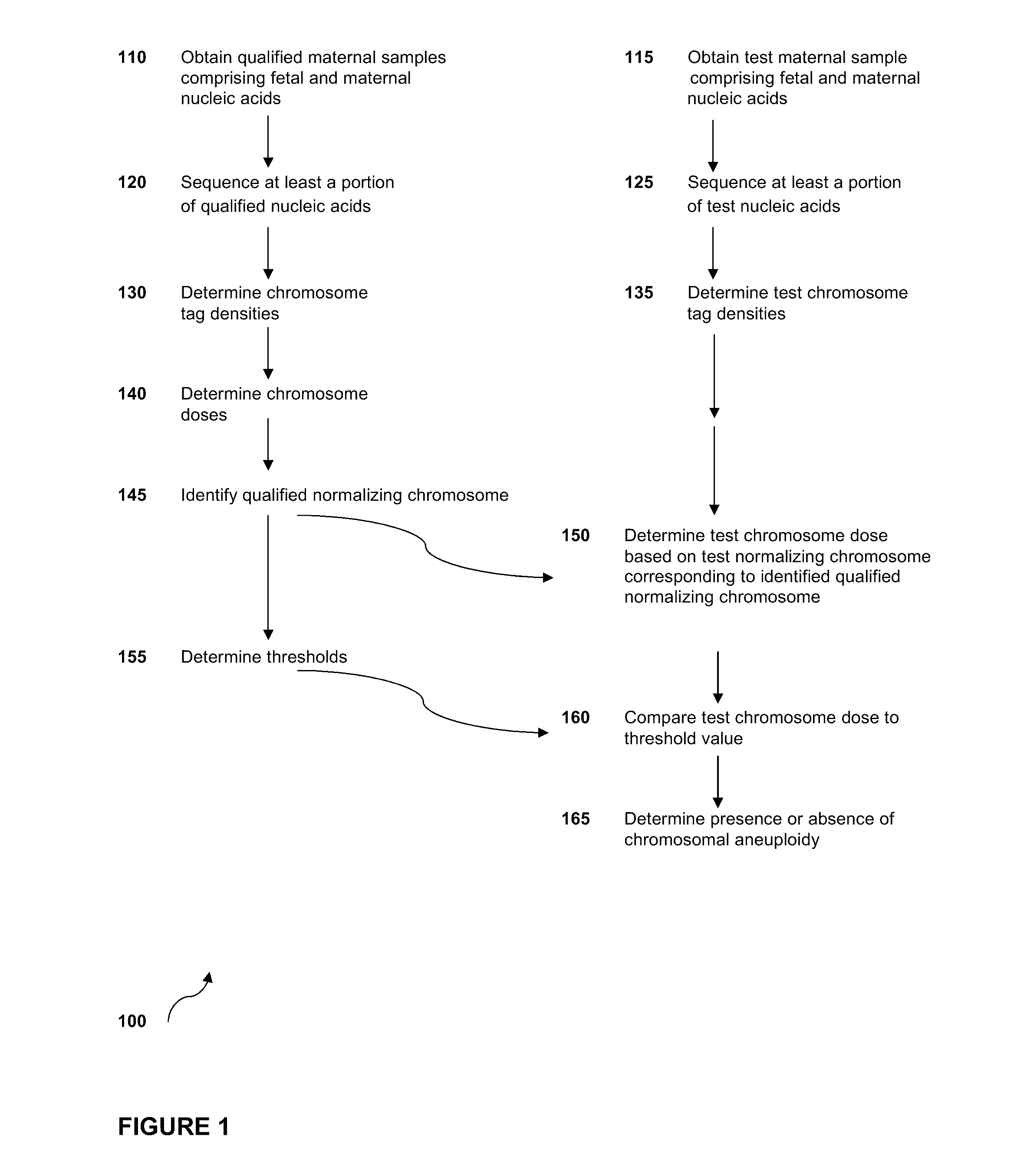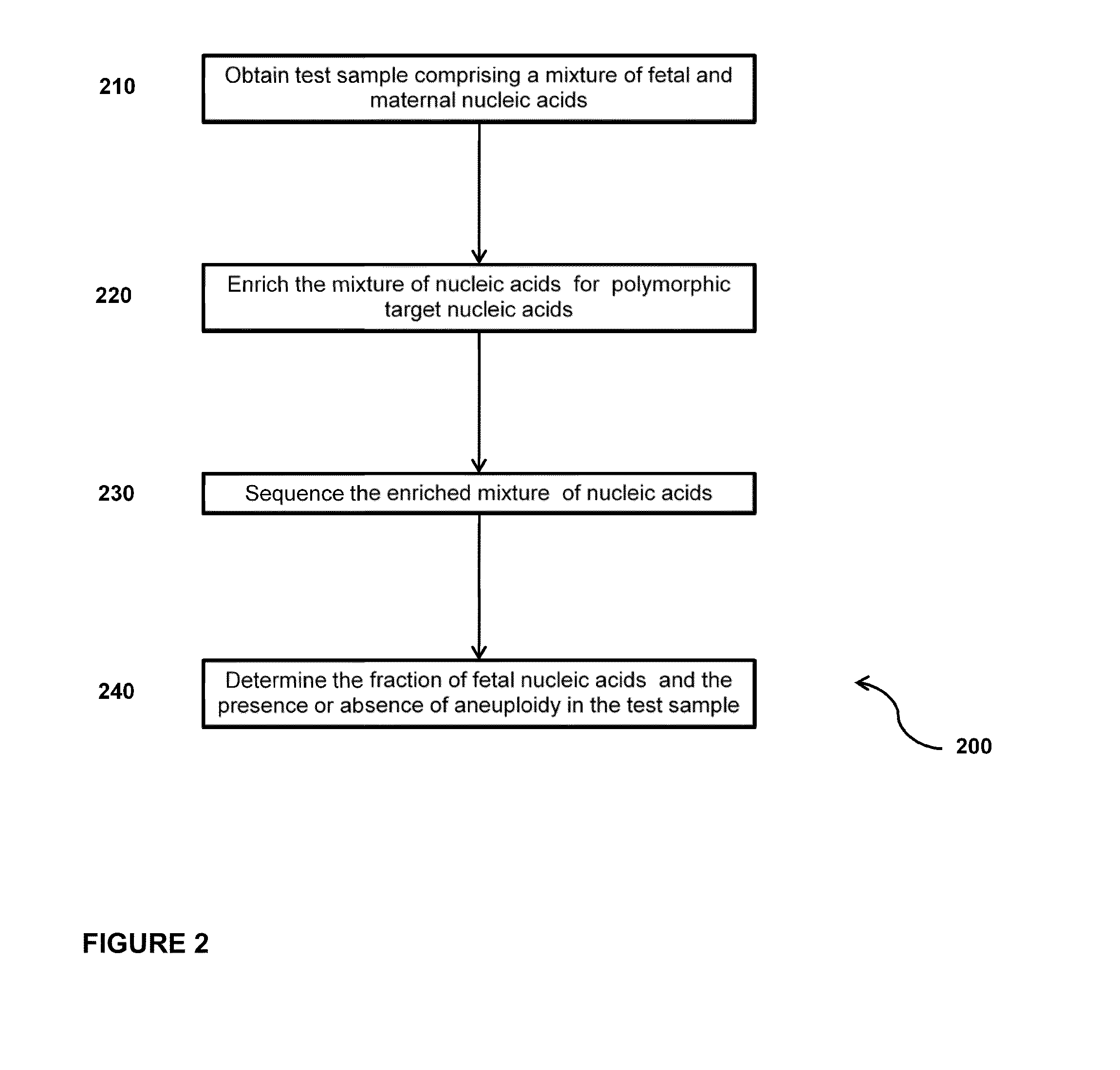Sequencing methods and compositions for prenatal diagnoses
a sequencing method and prenatal diagnosis technology, applied in the field of prenatal diagnosis, can solve problems such as insufficient sensitivity, and achieve the effect of improving the quality of library dna
- Summary
- Abstract
- Description
- Claims
- Application Information
AI Technical Summary
Benefits of technology
Problems solved by technology
Method used
Image
Examples
example 1
Sample Processing and cfDNA Extraction
[0231]Peripheral blood samples were collected from pregnant women in their first or second trimester of pregnancy and who were deemed at risk for fetal aneuploidy. Informed consent was obtained from each participant prior to the blood draw. Blood was collected before amniocentesis or chorionic villus sampling. Karyotype analysis was performed using the chorionic villus or amniocentesis samples to confirm fetal karyotype.
[0232]Peripheral blood drawn from each subject was collected in ACD tubes. One tube of blood sample (approximately 6-9 mL / tube) was transferred into one 15-mL low speed centrifuge tube. Blood was centrifuged at 2640 rpm, 4° C. for 10 min using Beckman Allegra 6 R centrifuge and rotor model GA 3.8.
[0233]For cell-free plasma extraction, the upper plasma layer was transferred to a 15-ml high speed centrifuge tube and centrifuged at 16000×g, 4° C. for 10 min using Beckman Coulter Avanti J-E centrifuge, and JA-14 rotor. The two centri...
example 2
Preparation and Sequencing of Primary and Enriched Sequencing Libraries
[0235]a. Preparation of Sequencing Libraries—Abbreviated Protocol
[0236]All sequencing libraries i.e. primary and enriched libraries, were prepared from approximately 2 ng of purified cfDNA that was extracted from maternal plasma. Library preparation was performed using reagents of the NEBNext™ DNA Sample Prep DNA Reagent Set 1 (Part No. E6000L; New England Biolabs, Ipswich, Mass.), for Illumina® as follows. Because cell-free plasma DNA is fragmented in nature, no further fragmentation by nebulization or sonication was done on the plasma DNA samples. The overhangs of approximately 2 ng purified cfDNA fragments contained in 40 μl were converted into phosphorylated blunt ends according to the NEBNext® End Repair Module by incubating in a 1.5 ml microfuge tube the cfDNA with 5 μl 10× phosphorylation buffer, 2 μl deoxynucleotide solution mix (10 mM each dNTP), 1 μl of a 1:5 dilution of DNA Polymerase I, 1 μl T4 DNA Po...
example 3
Massively Parallel Sequencing and Determination of Aneuploidy
[0243]Peripheral blood samples were obtained from pregnant subjects and cfDNA was purified from the plasma fraction as described in example 1. All sequencing libraries were prepared using the abbreviated library preparation protocol described in Example 2. The amplified DNA was sequenced using Illumina's Genome Analyzer II to obtain single-end reads of 36 bp. Only about 30 bp of random sequence information are needed to identify a sequence as belonging to a specific human chromosome. Longer sequences can uniquely identify more particular targets. In the present case, a large number of 36 bp reads were obtained, covering approximately 10% of the genome. Sequencing of library DNA was performed using the Genome Analyzer II (Illumina Inc., San Diego, Calif., USA) according to standard manufacturer protocols. Copies of the protocol for whole genome sequencing using Illumina / Solexa technology may be found at BioTechniques.™. Pro...
PUM
| Property | Measurement | Unit |
|---|---|---|
| diameter | aaaaa | aaaaa |
| birth weight | aaaaa | aaaaa |
| threshold value | aaaaa | aaaaa |
Abstract
Description
Claims
Application Information
 Login to View More
Login to View More - R&D
- Intellectual Property
- Life Sciences
- Materials
- Tech Scout
- Unparalleled Data Quality
- Higher Quality Content
- 60% Fewer Hallucinations
Browse by: Latest US Patents, China's latest patents, Technical Efficacy Thesaurus, Application Domain, Technology Topic, Popular Technical Reports.
© 2025 PatSnap. All rights reserved.Legal|Privacy policy|Modern Slavery Act Transparency Statement|Sitemap|About US| Contact US: help@patsnap.com



